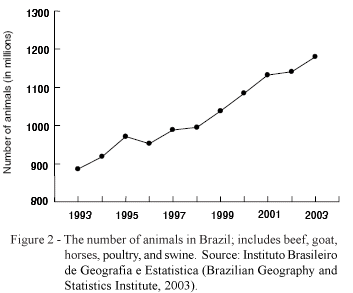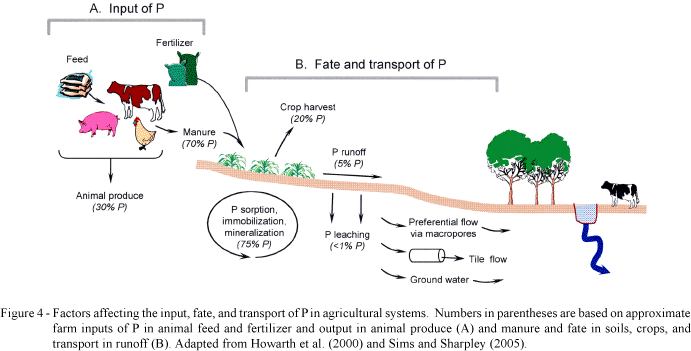Eutrophication has become a major threat to water quality in the U.S., Europe, and Australasia. In most cases, freshwater eutrophication is accelerated by increased inputs of phosphorus (P), of which agricultural runoff is now a major contributor, due to intensification of crop and animal production systems since the early 1990s'. Once little information is available on the impacts of Brazilian agriculture in water quality, recent changes in crop and animal production systems in Brazil were evaluated in the context of probable implications of the fate of P in agriculture. Between 1993 and 2003, there was 33% increase in the number of housed animals (i.e., beef, dairy cows, swine, and poultry), most in the South Region (i.e., Paraná, Rio Grande do Sul, and Santa Catarina States), where 43 and 49% of Brazil's swine and poultry production is located, respectively. Although grazing-based beef production is the major animal production system in Brazil, it is an extensive system, where manure is deposited over grazed pastures; confined swine and poultry are intensive systems, producing large amounts of manure in small areas, which can be considered a manageable resource. This discussion will focus on swine and poultry farming. Based on average swine (100 kg) and poultry weights (1.3 kg), daily manure production (4.90 and 0.055 kg per swine and poultry animal unit, respectively), and manure P content (40 and 24 g kg-1 for swine and poultry, respectively), an estimated 2.5 million tones of P in swine and poultry manure were produced in 2003. Mostly in the South and Southeast regions of Brazil (62%), which represent only 18% of the country's land area. In the context of crop P requirements, there was 2.6 times more P produced in manure (1.08 million tones) than applied as fertilizer (0.42 million tonnes) in South Brazil in 2003. If it is assumed that fertilizer P use represents P added to meet crop needs and accounts for P sorbed by soil in unavailable forms each year, if swine and poultry manure were to replace fertilizer, there would be an annual P surplus of 0.66 million tonnes in the South region alone. These approximations and estimates highlight that, similarly to other parts of the world, there is a potential for surplus P to quickly accumulate in certain regions of Brazil. Unless measures are developed and implemented to utilize manure P, repeated annual surpluses will create an increasingly difficult problem to solve. These measures can be grouped as source and transport management. Source management attempts to decrease dietary P, use feed additives, manure treatment and composting, as well as careful management of the rate, timing, and method of manure applications. Transport management attempts to control the loss of P in runoff from soil to sensitive waters via use of conservation tillage, buffer or riparian zones, cover crops, and trapping ponds or wetlands. These measures are discussed in the contest of Brazil's climate, topography, and land use, and how successful remediation programs may be implemented at farm and watershed level.
diffuse pollution; eutrophication; poultry production; swine production; surface runoff









